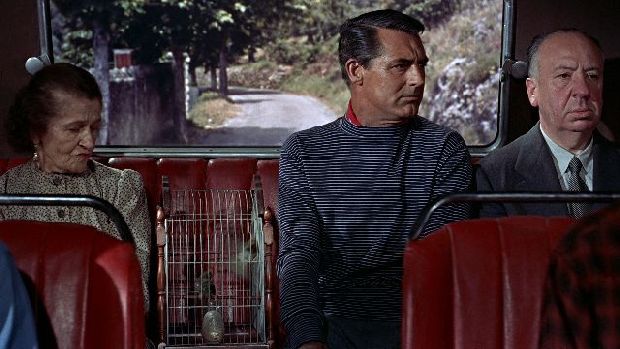To Catch a Thief (1955) 
“WANTED by the police in all the luxury-spots of Europe!… A catch for any woman!”

Director: Alfred Hitchcock
Cast: Cary Grant, Grace Kelly, Jessie Royce Landis
Synopsis: When a reformed jewel thief is suspected of returning to his former occupation, he must ferret out the real thief in order to prove his innocence.
With To Catch a Thief, Alfred Hitchcock once again returned to his favourite theme of an innocent man wrongfully accused and forced to go on the run in order to prove his innocence. But unlike most of his other movies which share the same theme, To Catch a Thief focuses much more on the obligatory romantic entanglement of his protagonist than on the thriller aspects, with the result that it fails to, well, thrill, in the way we might expect from a Hitchcock flick.
John Robie (Cary Grant — Alice in Wonderland, Bringing Up Baby) is a former cat burglar who retired from his lucrative career as a jewel thief in order to fight with the French resistance in WWII. With the Nazis long-defeated, Robie now lives in isolated splendour on the French Riviera, but his past catches up with him when a series of jewel thefts bear all the hallmarks of Robie’s old modus operandi. When the police come visiting, Robie makes his getaway and comes into contact with H. H. Hughson (John Williams — Dial M for Murder, Witness for the Prosecution), a British insurance agent who’s keen to see these revenue-damaging burglaries come to an end. After some persuasion, Hughson agrees to provide Robie with a list of prospective targets to help him track down the real culprit.
One of the first names on the list is Jessie Stevens (Jessie Royce Landis — The Swan, North by Northwest) who is holidaying on the Riviera with her glacially beautiful daughter, Frances (Grace Kelly — Mogambo, The Bridges at Toko-Ri). Robie wastes no time in making contact with them, and before long he’s embarking on a romance with the glamorous Frances. However, will the romance conflict with his investigation into the true identity of the copycat jewel thief?
Well, in terms of the movie, it certainly does. Given the talky nature of its screenplay, it would be quite easy to believe that To Catch a Thief was based on a stage play rather than a novel. It’s true that the verbal sparring between Robie and Frances is often witty and sophisticated, but because the two sub-plots are almost incidental to one another for much of the running time, they tend to clash rather than complement. The plots do eventually intertwine, but the protracted attention to the couple’s romance pretty much sucks the life out of the counterfeit thief plotline.
To Catch a Thief does at least ooze 1950s sophistication. Cary Grant, by then in his fifties, looks svelte and debonair, while Grace Kelly is radiantly beautiful. The film is also Hitchcock’s first work with VistaVision, and he makes superb use of it to capture some sumptuous location shots of the coasts and hills of the Riviera. If To Catch a Thief deserves any kind of praise, it’s for the way in which it provides us with a snapshot of the region in the mid-1950s rather than its lukewarm romance and predictable plot.
(Reviewed 11th July 2014)
Click below for a free preview of the Kindle book, The Films of Grace Kelly. The book, written by the author of this review, features reviews of all of the actor’s films, and is available to buy, or to read for free if you’re a member of Kindle Unlimited.
httpv://www.youtube.com/watch?v=hfyrCCcZFlc
